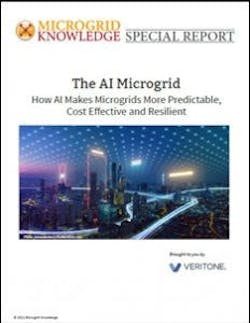How AI Makes Microgrids More Predictable, Cost Effective and Resilient
A new white paper from Veritone explores how artificial intelligence (AI) can be used in the planning, deployment and operation of microgrids.
Get the full report.
According to the paper, “power consumers increasingly rely on microgrids for greater energy reliability, cost savings and to reduce carbon emissions. Microgrids act as decentralized power resources that can island away from the central grid when necessary, such as during a power outage, and deliver power to their host from on-site energy sources.” Effective microgrids need to balance fuel availability, price, emissions, unpredictable energy demand and a variety of other factors so that they can optimize the diverse mix of resources in real-time, or better yet, predictively. In other words, they need to be able to predict the unpredictable. That’s where artificial intelligence comes in.
“Not only must sophisticated microgrids provide reliable power, optimize load and capture market opportunities, but they also now need to balance the variability of renewables.” – Veritone, “The AI Microgrid: How AI Makes Microgrids More Predictable, Cost Effective and Resilient“
Artificial intelligence, according to Veritone, “is the ability of a “machine”— via computing iterations and algorithms — to perform cognitive functions ordinarily associated with the biological human mind.” When integrated into a microgrid, “AI can handle the massive data volumes required to continuously monitor the state of energy generation and storage devices on both the grid and the microgrid,” according to the paper. AI can also simultaneously consider data around energy demand, weather, and energy price.
AI performs these calculations at a speed that could never be replicated by a person, and ultimately provides developers, equipment providers, and operators with the ability to “predict, model, simulate, optimize and autonomously control microgrids.”
In the white paper, Veritone presents three different case studies around how they’ve used AI in the planning and development of microgrid projects. The real-world examples include a cryptocurrency mining data center, the US General Services Administration and an energy storage services provider.
Download the full report, “The AI Microgrid: How AI Makes Microgrids More Predictable, Cost Effective and Resilient” from Veritone.
About the Author
Kathy Hitchens
Special Projects Editor
I work as a writer and special projects editor for Microgrid Knowledge. I have over 30 years of writing experience, working with a variety of companies in the renewable energy, electric vehicle and utility sector, as well as those in the entertainment, education, and financial industries. I have a BFA in Media Arts from the University of Arizona and a MBA from the University of Denver.

